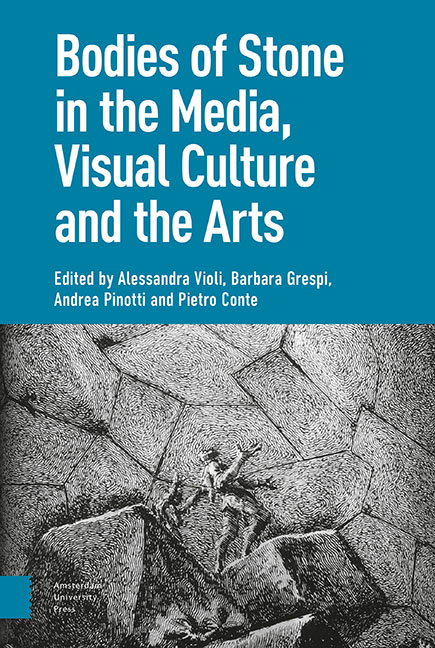Book contents
- Frontmatter
- Contents
- Introduction: Learning from Stone
- I Statue: The Imaginary of Uncertain Petrification
- 1 Theatre and Memory: The Body-as-Statue in Early Modern Culture
- 2 Translated Bodies: A ‘Cartographic’ Approach
- 3 Pantomime in Stone: Performance of the Pose and Animal Camouflage
- 4 Animated Statues and Petrified Bodies: A Journey Inside Fantasy Cinema
- 5 The Ephemeral Cathedral: Bodies of Stone and Configurations of Film
- II Matter: Size, Hardness, Duration
- 1 Bodies That Matter: Miniaturisation and the Origin(s) of ‘Art’
- 2 Brancusi’s ‘Sculpture for the Blind’
- 3 Cinema, Phenomenology and Hyperrealism
- 4 Ephemeral Bodies: The ‘Candles’ of Urs Fischer
- 5 The Celluloid and the Death Mask: Bazin’s and Eisenstein’s Image Anthropology
- III Corpse: Fossils, Auto-Icons, Revenants
- 1 Funeral Eulogy: Post-Mortem Figures and Redeemed Bodies, in Images
- 2 On Jack Torrance As a Fossil Form
- 3 Technical Images and the Transformation of Matter in Eighteenth-Century Tuscany
- 4 Glass, Mixed Media, Stone: The Bodily Stuffs of Suspended Animation
- 5 Bodies’ Strange Stories: Les Revenants and The Leftovers
- IV Monument: Embodying and Grafting
- 1 The Impassibly Fleshly, the Statue of the Impossible
- 2 Frozen into Allegory: Cleopatra’s Cultural Survival
- 3 The Orphan Image
- 4 The Well-Tempered Memorial: Abstraction, Anthropomorphism, Embodiment
- 5 Monuments of the Heart: Living Tombs and Organic Memories in Contemporary Culture
- Index
5 - The Celluloid and the Death Mask: Bazin’s and Eisenstein’s Image Anthropology
Published online by Cambridge University Press: 20 November 2020
- Frontmatter
- Contents
- Introduction: Learning from Stone
- I Statue: The Imaginary of Uncertain Petrification
- 1 Theatre and Memory: The Body-as-Statue in Early Modern Culture
- 2 Translated Bodies: A ‘Cartographic’ Approach
- 3 Pantomime in Stone: Performance of the Pose and Animal Camouflage
- 4 Animated Statues and Petrified Bodies: A Journey Inside Fantasy Cinema
- 5 The Ephemeral Cathedral: Bodies of Stone and Configurations of Film
- II Matter: Size, Hardness, Duration
- 1 Bodies That Matter: Miniaturisation and the Origin(s) of ‘Art’
- 2 Brancusi’s ‘Sculpture for the Blind’
- 3 Cinema, Phenomenology and Hyperrealism
- 4 Ephemeral Bodies: The ‘Candles’ of Urs Fischer
- 5 The Celluloid and the Death Mask: Bazin’s and Eisenstein’s Image Anthropology
- III Corpse: Fossils, Auto-Icons, Revenants
- 1 Funeral Eulogy: Post-Mortem Figures and Redeemed Bodies, in Images
- 2 On Jack Torrance As a Fossil Form
- 3 Technical Images and the Transformation of Matter in Eighteenth-Century Tuscany
- 4 Glass, Mixed Media, Stone: The Bodily Stuffs of Suspended Animation
- 5 Bodies’ Strange Stories: Les Revenants and The Leftovers
- IV Monument: Embodying and Grafting
- 1 The Impassibly Fleshly, the Statue of the Impossible
- 2 Frozen into Allegory: Cleopatra’s Cultural Survival
- 3 The Orphan Image
- 4 The Well-Tempered Memorial: Abstraction, Anthropomorphism, Embodiment
- 5 Monuments of the Heart: Living Tombs and Organic Memories in Contemporary Culture
- Index
Summary
Abstract
Funereal images are characterised by a peculiar dialectic tension between presence and absence that plays a crucial role in understanding the anthropological roots of image-making tout court. Building on Bazin and Eisenstein's remarks about the longue duréeof funerary practices aimed at preserving the visual appearances of dead bodies after their disappearance due to physical decay, this essay offers a genealogy of techniques that from casting, moulding and embalming eventually leads to the recording of images onto celluloid film. The death mask, in particular, with its capacity of capturing and fixing through the imprint process the traits of a face that was once alive, seems to respond to that same need to arrest time and ‘secure phenomena’ to which photography and cinema would later respond.
Keywords: Cinema; photography; Eisenstein; Bazin; media archaeology
One may believe that these people have lived, breathed, thought, in the very moment in which they were photographed, but in the contact with the instrument they have solidified, they have petrified [sind sie erstarrt, versteinert] —a result, which is similar to the casting of a death mask, which always resembles a corpse, even when an artist intervenes on it.‒ Moritz Thausing,
‘Kupferstich und Photographie’, 1866In the chapter ‘Image and Death. Embodiment in Early Cultures’ of his An Anthropology of Images. Picture Medium Body—the English translation of a book published in German in 2001 with the title Bild-Anthropologie. Entwürfe für eine Bildwissenschaft—Hans Belting writes that ‘the anthropology of images must probe the origins of the image and of its connection to death in order to advance our understanding of the ways in which we interact symbolically with the image’. Firmly rooted in the German tradition of philosophical anthropology that begins with Kant's Anthropologie in pragmatischer Hinsicht(1796-1797), that continues with figures such as Helmuth Plessner and Arnold Gehlen, and is further developed today within the context of a branch of German media theory known as Medienanthropologieor Mediale Anthropologie, Belting's Bild-Anthropologieis centred on the triad ‘picture – medium – body’ and considers the body ‘as a living medium for images’: a ‘medium’ that operates ‘by processing, receiving, and transmitting images’.
- Type
- Chapter
- Information
- Bodies of Stone in the Media, Visual Culture and the Arts , pp. 189 - 204Publisher: Amsterdam University PressPrint publication year: 2020

